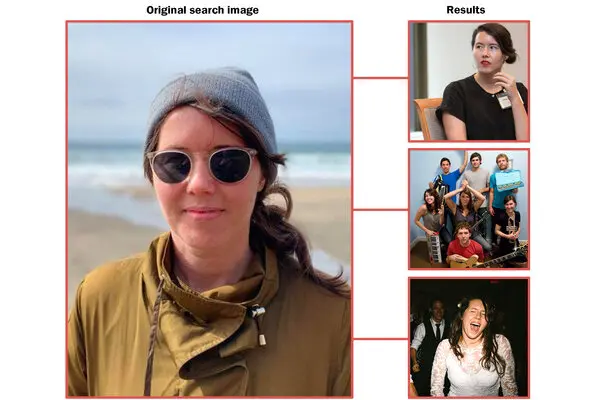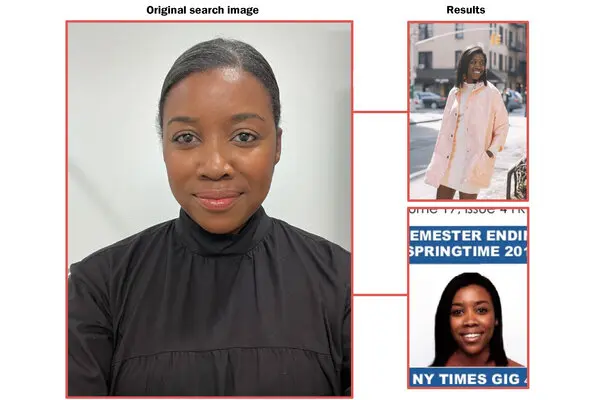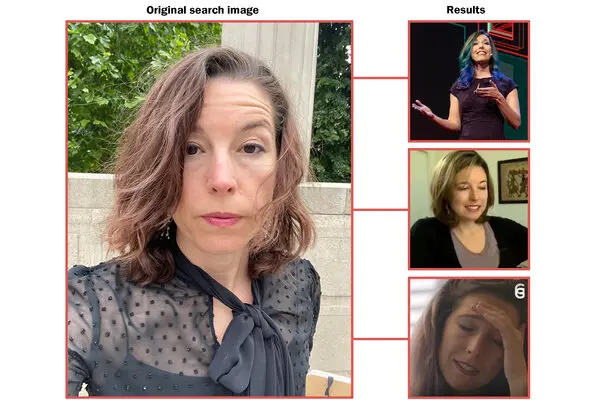It was reported on May 28 that Clearview AI, a face recognition startup, recently caused a lot of controversy due to the unauthorized collection of face images. However, compared with the paid face search engine named pimeyes, Clearview AI is like a witch in a small way. Pimeyes' search accuracy is amazing, and it only takes a few seconds to identify the people in the picture.




Pimeyes charges $29.99 a month. It has a super ability similar to that from the science fiction world, that is, it scans faces to find similar pictures on the Internet and provides links containing pictures. Each search takes only a few seconds. With the consent of more than a dozen reporters, the New York Times used pimeyes to scan their faces to test their ability.
Super fast matching speed and amazing accuracy
Pimeyes found almost everyone's photos, some of which even the journalists themselves had never seen before, even though they were wearing sunglasses or masks, or their faces were not aimed at the camera. Pimeyes found a picture of a reporter dancing at an art museum ten years ago and crying after being proposed. Although she didn't like this photo, the photographer privately decided to use it to advertise on yelp.
At the 2011 Coachella Music Festival, a science and technology reporter found himself in his youth among a group of embarrassed fans. A foreign reporter appeared in countless wedding photos. Obviously, he likes parties very much. One reporter's past life in a rock band was discovered, and another reporter's preference for summer camp vacation was also exposed.
However, unlike Clearview AI, a similar facial recognition tool for law enforcement agencies only, pimeyes does not include search results from social media sites. Pimeyes sometimes displays unexpected pictures from news reports, wedding photography websites, review websites, blogs or adult websites. The faces of the dozen journalists were accurately matched. For women, the wrong photos often come from adult websites, which makes people feel uneasy.
A technology executive who asked for anonymity said that he often used pimeyes to identify the people who harassed him on Twitter and confirm their real photos on their accounts. Another pimeyes user who asked for anonymity said that he used the tool to identify the real identity of actresses from adult movies and search for sexy photos of friends on Facebook.
The new boss of pimeyes is Giorgi gobronidze, a 34 year old university professor. He believes that pimeyes can become a good tool to help people protect their online reputation. For example, journalists who do not like photographers using their photos can now ask the latter to delete their proposed photos from the yelp page.
Gobronizer said that users of pimeyes should only search for facial images of themselves or those who agree to be searched. But he said he only hoped that people would act "in an ethical way" and could do nothing about the technology's infringement on people's ability to remain anonymous. Pimeyes does not have any control measures to prevent users from searching other people's facial images, and suggests users to pay a high fee to prevent photos taken at night that may have negative effects from being exposed.
Ella jakubowska, policy adviser to the privacy advocacy group European digital rights organization, said: "no matter how justified, pimeyes is undoubtedly deliberately designed tracking software."
University professors take over the controversial company
Gobronizer started his teaching career in 2014, teaching at European universities in Georgia. In 2017, he participated in an exchange program and lectured at a university in Poland. At that time, one of his students introduced him to two "hackers", namely lucaszkowalczyk and Denis tatina, who were studying facial search engines.
Gobronizer said that kovalcik and tatina agreed to discuss their invention in his academic research, which eventually became pimeyes. The two explained how their search engine used neural network technology to map the features of human faces in order to match them with faces with similar sizes, and the program could learn how to match better over time. "When I first heard about this technology, I felt like I was from the stone age, like reading science fiction," he said
Gobronizer kept in touch with the two founders and witnessed that pimeyes began to get more and more attention in the media. In 2020, pimeyes claimed that he had changed his boss, and the company's headquarters moved from Poland to Seychelles. Sometime last year, gobronizer "heard" that pimeyes were being sold. As a result, he quickly raised funds and made a takeover offer, but he would not disclose how much he ultimately spent.
In December last year, gobronizer founded a company called emearorobotics, acquired pimeyes and registered it in Dubai because the tax rate in the UAE is very low. Gobronizer retained most of pimeyes' technical and support teams and hired a consulting firm in Belize to deal with advisory and regulatory issues. Now a businessman and owner of a controversial company, gorbronize hopes to create a world where anyone can use facial recognition technology.
"It's essentially extortion"
A few months ago, computer engineer Cher Scarlett first tried pimeyes, but what she found was the memory she tried to forget. In 2005, when the 19-year-old Scarlett went bankrupt, she considered taking up the job of . She went to New York for an audition, but eventually gave up the idea.
Pimeyes discovered Scarlett's experience and provided relevant links to find her explicit photos on the Internet. Scarlett is committed to safeguarding labor rights and interests and( https://apple.pvxt.net/c/1251234/435400/7639?u=https%3A%2F%2Fwww.apple.com%2Fcn%2Fmusic%2F ) Led a high-profile strike and became the object of media coverage. "Before that, I had no idea that these photos had been uploaded to the Internet," she said
Fearing that people would react negatively to these pictures, Scarlett immediately began to study how to delete them. When she clicks one of the photos on pimeyes, a menu will pop up, which provides a link containing the picture, a link to the website where the picture is located, and an option to "delete from the public results" on pimeyes.
However, Scarlett soon found that only subscribers who paid $89.99 to $299.99 per month for the "protection plan" could enjoy the photo deletion service. Scarlett said, "this is essentially extortion," but she eventually had to pay. Gobronizer disagrees with such allegations. He argued that there was a free tool in the pimeyes index, which could delete the results without significant advertising effect on the website. He also provided a receipt showing that pimeyes had refunded $299.99 to Scarlett last month.
Gomeyes has tens of thousands of subscribers, and most of its visitors come from the United States and Europe. Most of its revenue comes from subscribers to its protection services. Pimeyes also has a free "opt out" feature that allows people to delete their own data from the website, including search images of their faces. In order to quit, Scarlett provided her teenage photos and scanned her ID card. In early April, she confirmed that her opt out request had been accepted.
Pimeyes wrote in an email: "potential search results containing your face will be deleted from our system." But a month later, with Scarlett's permission, the New York Times conducted a pimeyes search on her face pictures and got more than 100 results, including those explicit photos.
Gobronizer said that this was a "regrettable result" and that choosing to exit did not prevent a person's face from being searched. Instead, it will only screen any facial photos with "high similarity" when choosing to exit from pimeyes' search results, which means that if people want to stay away from pimeyes search, they need to choose to exit regularly and submit more photos of themselves.
Gobronizer said that deleting explicit photos is particularly tricky. He compared the trend of their spread on the Internet to the mythical Hydra. "If one head is cut off, two more heads will appear," he said Gobronizer wants people to use pimeyes in an "ethical" way, which means that people are required to search only for facial images of themselves rather than strangers.
But pimeyes almost failed to achieve the whole goal, but the searcher had to click on a box to claim that the uploaded facial photos belonged to him. Helen Nissenbaum, a professor of privacy studies at Cornell University, said the move was "absurd". Unless the website has government identification provided by searchers, as Scarlett chose to quit, it will not be effective at all.
Nissenbaum added: "if this is effective and we want to know where our own facial images are, we must ensure that the company providing this service will be transparent and audited." However, pimeyes obviously will not conduct such an audit. However, gobronizer said that the website will prohibit "illogical" search activities. For example, it is obviously abnormal to search more than 1000 times a day.
Gobronizer relies on users to do the right thing, and warns that anyone who searches facial images of others without permission violates European privacy laws. "This should be the responsibility of the user, and we are just a tool supplier," he said
Scarlett said she never thought she would publicly talk about what happened when she was 19, but after realizing that the photos had been uploaded to the Internet, she felt she had to do something. "These photos will be used against me. I'm glad I was the first to find them, but for me, it's more because of luck than pimeyes' actions," she said
Rules and exceptions
Although gobronizer said that pimeyes can only be used to search users' own facial images, he is open to other uses as long as they are "ethical". He said that he supported the use of pimeyes by investigative journalists to help identify suspects who attacked the U.S. Capitol building on January 6, 2021.
The New York Times allows its reporters to report using a face recognition search engine, but has internal regulations on this practice. A spokesman for the newspaper said: "every request to use facial recognition tools for reporting needs to be reviewed and approved by the relevant person in charge and senior members of our legal department in advance to ensure that the use conforms to our standards and relevant laws."
A German data protection agency announced an investigation into pimeyes last year because it may have violated the European privacy law, the general data protection regulations, which includes strict rules on the use of biometric data. The investigation is continuing. Gobronizer said he had not received any information from German regulators, but was "eager to answer any questions they might raise".
Gobronizer said he was not worried about the investigation of privacy regulators because pimeyes operates in different ways. He said that pimeyes is like a digital card directory. It does not store photos or personal face templates, but stores personal image URLs associated with the facial features they contain. All this is public, he said, and pimeyes reminds users to search only for their own facial photos. However, whether this statement can convince regulators remains to be determined. (small)